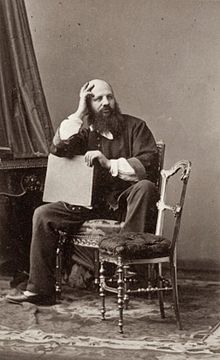André Adolphe Eugène Disdéri
| André-Adolphe-Eugène Disdéri | |
|---|---|

Self-portrait, c. 1860 (Paris, musée d'Orsay)
|
|
| Born |
28 March 1819 Paris |
| Died | 4 October 1889 Paris |
| Nationality | French |
| Occupation | Photographer |
| Years active | 1846–1870 |
| Known for | Photographic career as a daguerreotypist |
| Signature | |
 |
|
André-Adolphe-Eugène Disdéri (French: [ɑ̃dʁe adɔlf øʒɛn dizdeʁi]; 28 March 1819 – 4 October 1889) was a French photographer who started his photographic career as a daguerreotypist but gained greater fame for patenting his version of the carte de visite, a small photographic image which was mounted on a card. Disdéri, a brilliant showman, made this system of mass-production portraiture world famous.
Disdéri began his working life in a number of occupations, while also studying art. He started as a daguerreotypist in Brest in 1848 or 1849 but in December 1852 or January 1853 he moved to Nîmes. There he received assistance from Édouard Boyer and Joseph Jean Pierre Laurent with his photography-related chemistry experiments. After a year in Nîmes he moved to Paris, enabling easy access to people who would be the subjects of his cartes de visite.
Photographs had previously served as calling cards, but Disdéri's invention of the paper carte de visite (i.e. "visiting card") photograph second enabled the mass production of photographs. On 27 November 1854 he patented the system of printing ten photographs on a single sheet (although there is no evidence that a system printing more than eight actually materialized). This was the first patent ever for a carte de visite. Disdéri's's cartes de visite were 6×9 cm, about the size of conventional (nonphotographic) visiting cards of the time, and were made by a camera with four lenses and a sliding plate holder; a design inspired by the stereoscopic cameras.
The novelty quickly spread throughout the world. According to a German visitor, Disdéri's studio became "really the Temple of Photography - a place unique in its luxury and elegance. Daily he sells three to four thousand francs worth of portraits".
The fact that these photos could be reproduced inexpensively and in great quantity brought about the decline of the daguerreotype and ushered in a carte de visite craze as they became enormously popular throughout Europe and the United States. So great was the publicity that all of Paris wanted portraits.
...
Wikipedia
